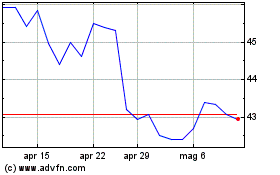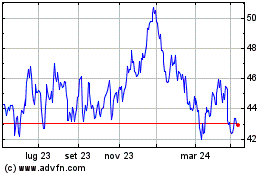BHP Annual Profit Falls by 58% on Weaker Commodity Prices
22 Agosto 2023 - 1:17AM
Dow Jones News
By Rhiannon Hoyle
Mining giant BHP Group on Tuesday said its annual profit more
than halved versus a year earlier, when it had benefited from the
sale of its oil-and-gas business and commodity prices at or near
record highs.
BHP, the world's biggest miner by market value, reported a net
profit of $12.92 billion for its fiscal year through June, down
from a profit of $30.90 billion in the same period a year earlier.
The year-prior result included an exceptional gain of $7.1 billion,
largely because of the merger of its petroleum unit with
Australia's Woodside Energy.
Analysts expected a profit of roughly $13.30 billion, according
to a Visible Alpha consensus compiled from 15 forecasts.
Directors declared a final dividend of 80 U.S. cents a share,
taking the miner's full-year payout to $1.70 a share. Analysts
expected a total dividend around $1.72 a share.
The miner said full-year dividend was still its third-largest
ordinary dividend on record.
BHP said its underlying profit, a closely watched measure that
strips out some one-time items, totaled $13.42 billion, down from
$23.82 billion the year prior.
"Our financial results for the year were strong, underpinned by
reliable production together with capital and cost discipline as we
managed lower commodity prices and inflationary pressures," said
Chief Executive Mike Henry.
Earnings were weighed by weaker commodity prices, which fell on
concerns about economic growth in China, the largest buyer of many
metals and minerals, and the outlook for developed countries after
sharp increases in interest rates.
In China, a drawn-out real estate crunch is especially worrying
for miners, given the importance of the sector to the country's
economy and metals demand. Another batch of disappointing economic
data for July, and a policy response that has so far underwhelmed,
has prompted a number of global investment banks to lower forecasts
on China's full-year growth rate.
"In the near term, China's trajectory is contingent on the
effectiveness of recent policy measures," Henry said.
The miner was paid 12% less for its copper last fiscal year
versus the year-prior period, and 18% less for iron ore, the key
ingredient in steel.
The average price for its metallurgical coal, also used to make
steel, was down by 22% year-on-year, after surging in 2022 in big
part due to supply concerns after Russia's invasion of Ukraine
disrupted trade flows.
Its own production was mostly higher. BHP produced more copper,
iron ore, nickel and thermal coal than the year-earlier period. Its
output of steelmaking coal was flat year-on-year.
Write to Rhiannon Hoyle at rhiannon.hoyle@wsj.com
(END) Dow Jones Newswires
August 21, 2023 19:02 ET (23:02 GMT)
Copyright (c) 2023 Dow Jones & Company, Inc.
Grafico Azioni BHP (ASX:BHP)
Storico
Da Mar 2024 a Apr 2024

Grafico Azioni BHP (ASX:BHP)
Storico
Da Apr 2023 a Apr 2024
